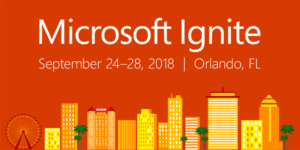
If you weren’t able to attend Microsoft Ignite 2018, as I wasn’t, there were a lot of great announcements by Microsoft in all product areas. I’ve done some research and pulled together the highlights of the announcements and in this blog post I’m going to focus on the key announcement areas specific to SharePoint Online, and the associated Microsoft online services. Unfortunately, there wasn’t a lot announced about SharePoint Server 2019.
NOTE: Not all of these announced features and capabilities are in production at this point and time. The expected release date for these features and capabilities is between 2018 Q4 and by the end of the first half of calendar year 2019.
There are so many announcements, I’m not even sure where to start…

I’ll begin by sharing the news on the modern intranet within SharePoint Online which now has some great new design options;
Megamenu layout for site and hub navigation – provides multiple levels of content hierarchy
Site level header layouts – allowing you to choose from standard, minimal, or compact layouts
Site level footer option – highlight common information at bottom of your site
Web parts – new countdown timer, and personalized web parts based on login credentials
Root site default template – root site of new tenants will use the Communication site template
Note: If have an existing root site that’s not a Communication site, you’ll be able to convert it using a new PowerShell command; Enable-CommSite
Also, in the SharePoint Online space, you’ll see improvements in the SharePoint Hub site that was introduced not too long ago. These new capabilities include;
Associate hub sites – create associated hub sites from within Hub site
Hub site administration – creation, association/disassociation from within SPO Admin center
Web parts – new Events web part to roll events up from hub-associated sites
Speaking of web parts, Microsoft announced enhancements to web parts and pages that include;
Webpart-to-webpart connections – web parts talk to web parts and pages for dynamic data
Page design reuse – design one page and use it multiple times to provide consistent experience
Page title region – more control over title region of page by choosing layout, alignment, etc.
Page section background shading – can add different colors to background of page sections
Enhancements to SharePoint lists and libraries that were announced;
Conditional formatting – add conditional color coding to SharePoint columns (no scripts needed)
View formatting – cut/paste scripts to create conditional formatting for reuse in other lists
Location column – column for tagging data with map coordinates, mailing address, and others
Easy list creation – build new lists from existing lists or Excel tables
SharePoint pages and list in Teams – browse to add list/library as tab to any channel
With Flow and PowerApps becoming so popular and powerful there were some announcements about those services as well;
PowerApps and Flow US GCC support – create solutions for U.S. GCC tenants
Flow for document management – move and copy files in O365 with Flow, and generate links
Flow for site management – build approval process to join a SharePoint site to a Hub site
PowerApps support for rich text fields – view and update rich text in formatted text columns
PowerApps forms in SharePoint mobile – link to PowerApps-based forms when using mobile app
PowerApps Auditing – monitor PowerApps administrator activity from within O365 Audit center
Microsoft Teams has become a very popular service, and is very well liked by many, including myself. I love how it brings together communication options and content options. Microsoft announced further integration with SharePoint and Teams by introducing;
Create a Team from group-connected team site – create a Team from existing modern team site
Libraries part of Teams channel – Identify Teams-connected library and access channel from it
SharePoint web parts in Teams – Add a SharePoint web part to a tab within a channel of a Team
Microsoft is constantly striving to improve the search experience, so it wouldn’t be a true Microsoft conference if there were some great announcements about Search. Microsoft announced they are expanding the Office 365 personalized search, introduced at Ignite 2017, to now encompass search inside and outside of Microsoft 365. (If you’re not familiar with Microsoft 365, it is an integrated bundle of Windows 10, Office 365, and Enterprise Mobility + Security or EMS). Microsoft will be using artificial intelligence (IA) from Bing to surface the results via Microsoft Graph. Your search results will not just include hyperlinks to information, it will also be a way to present answers to questions, provide suggestions, and allow you to take actions on your tasks.
These aren’t all the announcements about SharePoint, and the services that integrate with it, but it’s a majority of them that I thought you’d want to hear about. If you want more detail on the announcements made at Ignite, the sessions are available after you login to the Tech Community site found at:
https://techcommunity.microsoft.com/
Reminder: Not all of these announced features and capabilities are in production at this point and time. The expected release date for these features and capabilities is between 2018 Q4 and by the end of the first half of calendar year 2019. Microsoft will be making individual announcements as the new features and capabilities are released.